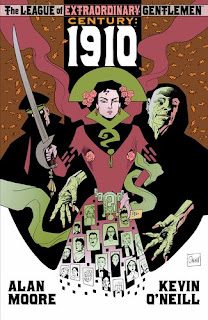The League of Extraordinary Gentlemen’s Century series was originally released in three volumes between 2010 and 2012 (wrapping up a year later than originally planned thanks to delays that now seem to be standard for any League title). They’re set, unsurprisingly, across a one hundred year span with each instalment offering something self-contained while at the same time contributing to a larger arc also detailed in the other two.
My feeling is that Century is where the League series
began to show signs of flagging. I still feel that it’s the best thing Moore’s
worked on, but this third volume does nothing to contribute to that. Rather it
simply avoids being bad enough to ruin what I enjoyed about previous entries.
If you’re not familiar with the concept the idea is that
Alan Moore (likely with some input from series artist Kevin O’Neill) has
fashioned a universe that incorporates every fictional character ever created, in
place of prominent real life figures. That idea is alive and well and is still
at the centre of things as the series kicks off with Century: What Keeps
Mankind Alive?, set in 1910. Sadly by the time the final part, Century: Let it
Come Down, rolls around it feels as if things have gone off the rails a bit and
the title has definitely lost a lot of its lustre.
The first chapter teases that it’s going to take the book
back to its roots. It’s set just a decade after the climax of the second
volume, which showed a failed Martian invasion of Earth. In the intervening
years the surviving members of the original line-up have disbanded and a new
gang, operating under the same name has formed.
Moore seems to go out of his way to emphasise that this
group is not as effective, or indeed charming, as the original. Which is in one
way fine and in another ay quite irritating. The author’s point seems to be
that this is a second string group both within the confines of the fictional
League universe as well as for him as a writer. He doesn’t seem to want them to
be viewed as the equals of their predecessors because they’re not as well-known
to readers and because within the narrative they are not as powerful. It’s a
nice idea but he does such a hatchet
job on the new League that the book becomes difficult to enjoy.
Paint it Black moves things forward to 1969. We get hints
at unseen line-ups but they amount to nothing substantial (which is in
character for Moore, but as a reader I’d like to know more about these groups).
Instead Moore focuses his efforts even more on the plot that threads the three
chapters together. It involves Oliver Haddo, an interpretation of Aleister
Crowley so metafictional I’m surprised the world didn’t implode when Moore
wrote it, jumping around some bodies and attempting to summon forth a Moonchild
who will end the world. For all he rails against generic superhero book-style plots
he seems to enjoy writing them.
The 1969 instalment comes complete with the obligatory
drug-induced dream sequences which are frankly a little lazy. They’re
impressively realised by O’Neill but you’d think that someone with Alan Moore’s
reputation and alleged inventiveness would be keen to buck trends and
stereotypes. To see him writing exactly the sort of thing everyone would expect
him to write for scenes set in 1969, and worse, exactly the sort of thing everyone
else writes, is disappointing.
The final chapter wraps everything up about as well as
can be expected. The Moonchild finally gets summoned and is revealed, to the
surprise of nobody familiar with the book’s internal logic, to be a Harry
Potter character. Of far more interest in the final volume is seeing the bleed
of television into the League world turn into an unstoppable flood. This
includes Moore writing The Thick Of It’s Malcolm Tucker. If you’re into
unexpected writer-character mash-ups you’ll probably find something to enjoy
about that.
The Century trilogy is where Moore seemed to stop writing
the League of Extraordinary Gentlemen to ensure there was a fun comic on
shelves and instead turns it into one of the many books he writes to show us
his theories and views on the world. It’s telling that the most enjoyable thing
about the entire two hundred page plus story is a short sequence which sees
Allan Quartermain spending some time as John Constatine at the end of the
1980s. That could have supported an entire issue in itself. That it was
relegated to a throwaway scene tells you all you need to know about where
Moore’s priorities lay when writing the series.



the ease of access to the material digitally. I also think another part of it is that the Bronze Age in general seems kind of under-rated by modern comic book fandom.
ReplyDelete